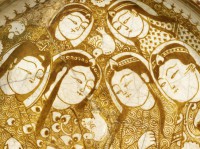Islamic Ceramics trail
Explore over one thousand years of development in Islamic ceramics through our extensive collection.

- This is a visual browsing tool that maps objects in this publication, gallery or collection trail by date of creation onto a timeline.
- The circular markers indicate where objects are on the timeline.
- The size of the markers indicates the relative number of objects at that point on the timeline.
- Hover over a marker to find out which objects are represented at that point in time.
- To expand, collapse or hide the timeline, click these symbols
 found at the top right of the timeline.
found at the top right of the timeline.
- 780
- 820
- 860
- 900
- 940
- 980
- 1020
- 1060
- 1100
- 1140
- 1180
- 1220
- 1260
- 1300
- 1340
- 1380
- 1420
- 1460
- 1500
- 1540
- 1580
- 1620
Introduction
This trail gives a brief introduction to the developments in ceramics manufacture in the Islamic Middle East, through the lens of the Ashmolean's collection.
In a journey of over a thousand years, the different sections explore how potters experimented with materials, made major technological breakthroughs, and developed a wide variety of decorative techniques.
The trail highlights the contacts between the Middle and Far East, and the specific impact this had on ceramics manufacture. It also looks at the importance of the Islamic world for the European ceramics industry, discussing the origin and use of techniques, such as tin glaze and lustre painting, which were a major source of inspiration to potters in Medieval and Renaissance Europe.
The Islamic ceramics collection
The Ashmolean Museum houses an extensive collection of Islamic ceramics, originating from a wide region stretching from Spain to Central Asia, and ranging in date from the earliest centuries of Islam to the 19th century. This collection has been shaped by significant gifts and bequests from several generous individuals from the late 19th century onwards. Among them are Charles Drury Fortnum (1888 and 1899), Sir Alan Barlow (1956), and, in particular, Gerald Reitlinger (1978).
These private collections now form the core of the Museum's Islamic ceramics collection, which has continued to grow to the present day thanks to new gifts and other acquisitions. A wealth of archaeological material from Islamic Syria, Iraq and Iran complements the collection of vessels and tiles, and makes it an invaluable resource for teaching and research.
Each chapter in this trail is illustrated with examples from the Museum's collection, all of which are on display in the new Islamic Middle East gallery from November 2009.
© 2013 University of Oxford - Ashmolean Museum



